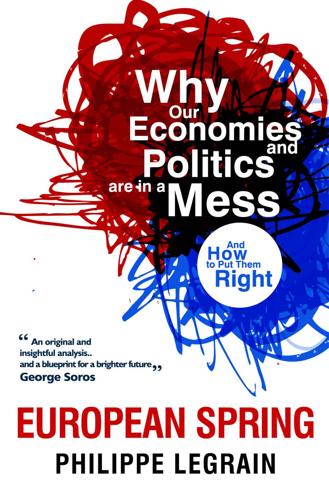
European Spring: Why Our Economies and Politics Are in a Mess - and How to Put Them Right
by
Philippe Legrain
Published 22 Apr 2014
It entrenched governments’ backstopping of bank debts, sparking fears about countries that had experienced an Irish-style bank-financed property bubble, notably Spain. And it threatened to drag even countries with a reasonably sound banking system, such as Italy, into the doom loop if the situation deteriorated. This doom loop was amplified by the other four big policy mistakes, which destabilised the bond yields of vulnerable sovereigns, worsening the banking crisis, and so on. But eurozone leaders didn’t even officially recognise the problem until their June 2012 summit.133 Even now they have yet to sever the link.
…
In fact, with the notable exception of Greece, it was primarily a banking crisis associated with excessive private borrowing for which the solution was bank restructuring, debt write-downs and policies to support investment and economic adjustment. As a result of these five catastrophic policy mistakes, however, the crisis evolved into a “doom loop” that dragged weak banks, weak governments and weak economies down together, exacerbated by self-defeating austerity and amplified by a systemic, self-fulfilling panic that governments would be unable to refinance their debts, forced to default and the euro would break up. Mistake one: the banks Fragile to start off with, punctured by losses on bad loans in the bubble years, the eurozone’s tightly interconnected banks stopped lending to each other when the crisis struck, forcing the ECB to step in.
…
Together, that would deal a further blow to Italian government bonds, because it could prompt panic selling by banks and would increase the risk that banks would receive a government bailout. Britain was fortunate in this regard: domestic government bonds accounted for only 1.3 per cent of UK banks’ assets. To add insult to injury, the doom loop between distressed banks and weak sovereigns drags down economies too. Rising government bond yields push up interest rates for bank borrowers. Distressed banks stop lending, pushing economies into recession. Struggling governments may raise taxes or cut spending, dealing a further blow. A weaker economy, in turn, further corrodes both banks’ balance sheets (as more households and businesses are unable to repay their loans) and governments’, as tax revenues fall and social spending rises.
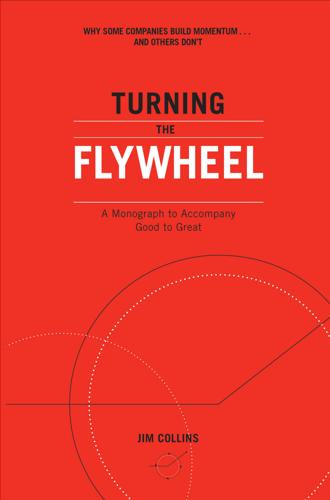
Turning the Flywheel: A Monograph to Accompany Good to Great
by
Jim Collins
Published 26 Feb 2019
Trace your way around the Amazon flywheel a few times in your mind, and you can almost get swept up in the momentum. Each component in the flywheel sets you up for the next component, indeed, almost throwing you around the loop. Bezos and his team could have panicked during the dot-com bust, abandoned the flywheel, and succumbed to what I described in Good to Great as the doom loop. When caught in the doom loop, companies react to disappointing results without discipline—grasping for a new savior, program, fad, event, or direction—only to experience more disappointment. Then they react without discipline yet again, leading to even more disappointment. Instead, Amazon committed fully to its flywheel and then innovated aggressively within that flywheel to build and accelerate momentum.
…
In our research for How the Mighty Fall, we found that the demise of once-great companies happens in five stages: (1) Hubris Born of Success, (2) Undisciplined Pursuit of More, (3) Denial of Risk and Peril, (4) Grasping for Salvation, and (5) Capitulation to Irrelevance or Death. Take special note of Stage 4, Grasping for Salvation. When companies fall into Stage 4, they succumb to the doom loop, the exact opposite of building flywheel momentum. They grasp for charismatic saviors or untested strategies or big uncalibrated cannonballs or cultural revolutions or “game-changing” acquisitions or transformative technologies or radical restructurings (then another and another) or . . . well, you get the idea.
…
If Circuit City had continued to evolve and renew the consumer electronics superstores (as Best Buy did) and continued to extend its underlying flywheel into new arenas (such as with CarMax), it might have remained a great company, climbing steadily upward in the S&P 500. Instead, Circuit City lost all its flywheel momentum and careened into the later stages of decline—down, down, down, the doom loop hurtling the company toward irrelevance. The once good-to-great company died in the winter of 2008.27 THE VERDICT OF HISTORY After conducting a quarter-century of research into the question of what makes great companies tick—more than six thousand years of combined corporate history in the research data base—we can issue a clear verdict.

Unhappy Union: How the Euro Crisis - and Europe - Can Be Fixed
by
John Peet
,
Anton La Guardia
and
The Economist
Published 15 Feb 2014
This increasingly fraught time culminated in angry confrontations at the G20 summit in Cannes in November 2011, where the prime ministers of Greece and Italy were summoned for a dressing-down by fellow leaders and subsequently pushed out of office. In the second phase there was a growing realisation of the need to come up with a more systemic response. Seeking to halt the “doom-loop”, in which weak banks and weak governments were dragging each other down, leaders embarked on the process of creating a banking union in June 2012. Soon thereafter, the ECB stepped in as a more credible lender of last resort for governments after Draghi declared the bank would do “whatever it takes” to stop the euro from breaking up.
…
First, at a summit in June, Merkel and other leaders agreed to centralise financial supervision around the ECB and then have the option of recapitalising troubled banks directly from the euro zone’s rescue funds. The move held out the promise, for the first time, of a banking union in which the risks of the financial sector would be shared. The aim was to break the doom-loop between weak banks and weak governments that threatened to destroy both, especially in Spain. The second, even more important, development that summer was Draghi’s declared readiness to intervene in bond markets without pre-set limits, on condition that troubled countries sought a euro-zone bail-out and adjustment programme.
…
In the Commission’s book on the euro, EMU@10,5 published in 2008 just ahead of the tenth anniversary of the start of the monetary union, there is mention of worries about imbalances, the divergence of economies and the dangers lurking in the banking system. But nowhere in its 320 turgid pages did it issue a clear warning, of the sort that some independent economists were voicing, about the risks of a self-fulfilling market panic, or of a destructive doom-loop between banks and sovereigns, or of large contingent liabilities in banks ending up on the books of already overindebted sovereigns. The clearest message was one of self-congratulation over the “resounding success” of the euro. It had boosted economic stability, cross-border trade, financial integration and investment, declared the authors.
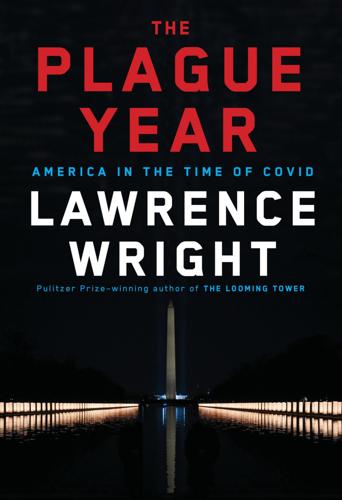
The Plague Year: America in the Time of Covid
by
Lawrence Wright
Published 7 Jun 2021
As policymakers addressed the greatest economic crisis in nearly a century, Hubbard warned them that it was more dire than they imagined. “I and other economists had been worried about a doom loop since the beginning of the pandemic,” Hubbard recalled. A doom loop is a term in modern economics that means a cycle of negative feedback. When the pandemic hit, the world suffered a supply shock: trade was disrupted, factories closed, stores shuttered. If workers didn’t start earning again soon, the supply shock could turn into a demand shock, which would further weaken supply, which would increase unemployment and further diminish demand. The doom loop. In mid-March Hubbard spoke with Republican senators Marco Rubio, Susan Collins, and Roy Blunt.
…
isbn 9780593320723 lccn: 2021932374 Ebook ISBN 9780593320730 Cover photograph by Callaghan O’Hare / Reuters / Alamy Cover design by Chip Kidd ep_prh_5.7.0_c0_r0 In memory of those no longer with us Contents Prologue 1. “It’s Going to Be Just Fine” 2. The Trickster 3. Spike 4. “An Evolving Situation” 5. “Flatten the Curve” 6. “It’s Coming to You” 7. “Nothing Can Stop What’s Coming” 8. The Doom Loop 9. “Let It Be March” 10. “It’s Like a Wind” 11. Bellevue 12. The No Plan Plan 13. Little Africa 14. The Mission of Wall Street 15. The Man Without a Mask 16. Waves 17. I Can’t Breathe 18.
…
*2 The infection fatality rate in the spring in New York City, despite the lockdown, was still 1.39 percent, and no doubt would have been much higher without the interventions. Wan Yang et al., “Estimating the Infection-Fatality Risk of SARS-CoV-2 in New York City during the Spring 2020 Pandemic Wave: A Model-Based Analysis,” The Lancet, Oct. 19, 2020. 8 The Doom Loop The first reported case of Covid in Washington, D.C., was on March 7. The virus was no longer “out there,” it was in the capital, possibly in the same neighborhoods where the Coronavirus Task Force members and their families lived. The CDC’s Robert Redfield observed that there were 3,656 new cases worldwide, and only 46 were in China.
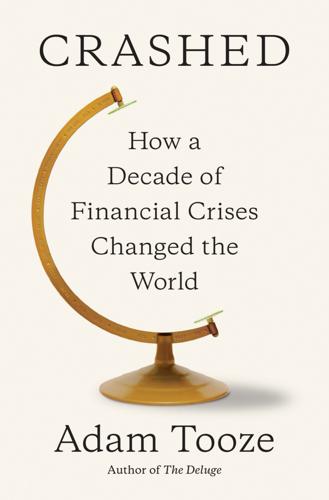
Crashed: How a Decade of Financial Crises Changed the World
by
Adam Tooze
Published 31 Jul 2018
Bailouts 8. “The Big Thing”: Global Liquidity 9. Europe’s Forgotten Crisis: Eastern Europe 10. The Wind from the East: China 11. G20 12. Stimulus 13. Fixing Finance Part III EUROZONE 14. Greece 2010: Extend and Pretend 15. A Time of Debt 16. G-Zero World 17. Doom Loop 18. Whatever It Takes Part IV AFTERSHOCKS 19. American Gothic 20. Taper Tantrum 21. “F*** the EU”: The Ukraine Crisis 22. #Thisisacoup 23. The Fear Projects 24. Trump 25. The Shape of Things to Come Notes Index About the Author Acknowledgments This book was written with urgency and I am deeply grateful to those who have made it happen.
…
The eurozone crisis was a massive aftershock of the earthquake in the North Atlantic financial system of 2008, working its way out with a time lag through the labyrinthine political framework of the EU.35 As one leading EU expert closely associated with the EU’s bailout programs has put it: “If we had taken the banks under central supervision then already [in 2008], we would have solved the problem at a stroke.”36 Instead the eurozone crisis expanded into a doom loop of private and public credit and a crisis of the European project as such. How do we account for the strange morphing of a crisis of lenders in 2008 into a crisis of borrowers after 2010? It is hard not to suspect sleight of hand. While Europe’s taxpayers were put through the mill, the banks and other lenders got paid out of money pumped into the bailout countries.
…
Since January 2009 the Obama administration had been straining every muscle to put the lid on popular discontent. Rather than seeking to mobilize the indignation simmering in American society, it had found one technocratic fix after another. Two years later the result was a spectacular delegitimization from both the Left and the Right. Chapter 17 DOOM LOOP On September 1, 2011, Pedro Passos Coelho, Portugal’s new prime minister, made his first visit to Berlin. His host, Chancellor Merkel, began the joint press conference by announcing how pleased she was to hear that the troika had just submitted its first report on Portugal’s structural adjustment program and had declared itself satisfied with the progress being made.
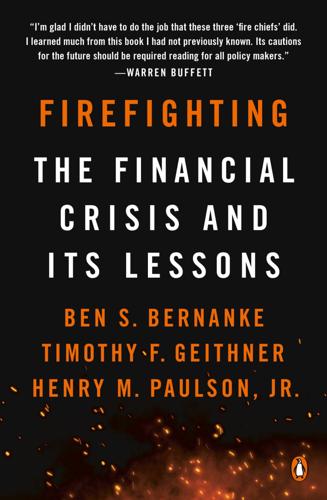
Firefighting
by
Ben S. Bernanke
,
Timothy F. Geithner
and
Henry M. Paulson, Jr.
Published 16 Apr 2019
But once the housing bubble popped, fear of losses created a financial stampede, as investors and creditors frantically reduced their exposure to anything and anyone associated with mortgage-backed securities, triggering fire sales (where cash-starved investors are forced to sell their assets at any price) and margin calls (where investors who bought assets on credit are forced to put up more cash) that in turn triggered more fire sales and margin calls. The financial panic paralyzed credit and shattered confidence in the broader economy, and the resulting job losses and foreclosures in turn created more panic in the financial system. A decade later, that doom loop of financial fear and economic pain has begun to recede in the public memory. But it’s hard to overstate just how chaotic and frightening it was. A one-month period starting in September 2008 included the sudden nationalization of the mortgage giants Fannie Mae and Freddie Mac, the largest and most surprising government intervention in financial markets since the Depression; the failure of the venerable investment bank Lehman Brothers, the largest bankruptcy in U.S. history; the collapse of the brokerage firm Merrill Lynch into the arms of Bank of America; an $85 billion government rescue of the insurer AIG to prevent an even larger bankruptcy than Lehman’s; the two largest failures of federally insured banks in U.S. history, those of Washington Mutual and Wachovia; the extinction of the investment bank model that had become synonymous with modern Wall Street; the first-ever government guarantees for more than $3 trillion worth of money market funds; the backstopping of a further $1 trillion worth of commercial paper; and congressional approval, after an initial market-crushing rejection, of a $700 billion arsenal of government support for the entire financial system.
…
When it goes, it usually goes quickly, and it’s hard to get back. A financial crisis is a bank run writ large, a crisis of confidence throughout the system. People get scared and want their money back, which makes the money remaining in the system less safe, which makes more people want their money back, a self-reinforcing doom loop of fear, fire sales, capital shortfalls, margin calls, and credit contractions that can produce a stampede for the exits. Once a stampede begins, it becomes rational to run to avoid getting trampled, and hesitation can be deadly. Perception and reality both matter, because runners will keep running until they’re confident not only that they don’t have a rational reason to run, but that others will have the confidence to stop running as well.
…
It looked like we were improvising again, but in a crisis, it’s vital to have the courage to change course when the times demand it. One reason the fire still looked so ominous despite our upgraded firefighting equipment was the worsening state of the broader economy. It had slipped into recession the previous December, but the turmoil of the fall had accelerated the doom loop between the financial sector and the real economy: job losses and loan defaults, further sapping confidence and depressing asset prices, leading to more belt-tightening, layoffs, defaults, and fire sales, deepening the financial crisis as well as the economic downturn. As the economy imploded, it became increasingly rational to assume the worst about struggling U.S. financial firms.

The Default Line: The Inside Story of People, Banks and Entire Nations on the Edge
by
Faisal Islam
Published 28 Aug 2013
He wore a T-shirt sporting the slogan Greek Sea Not in Crisis over a picture of an azure lagoon. The riots and the tear gas were only rare occurrences in Athens, he said, before correcting himself. ‘The riots are in fact only in two squares in Athens: Syntagma and Omonia.’ Still, everything was conspiring to push Greece into the doom loop of a collapsing economy: higher unemployment, lower take-home pay, lower spending, lower tax receipts and stubbornly high deficits. On top of that, tourism – representing one-fifth of the Greek economy, and one in five jobs – was being crushed by the images of social unrest beamed into Europe’s living rooms.
…
The problem was the combination of public debt, private debt and bank debt. Britain could not take the risk of immediately losing its AAA rating, resulting in much higher gilt rates, not because of the risk of sovereign bankruptcy, but because of the interaction of sovereign-debt funding with banking funding stress. This was the so-called doom loop. The gilt salesmen were peppered with questions from foreign central banks about Britain’s over-large financial system. And in the PowerPoint scattergram (‘Risks from financial sector and fiscal position’), which mapped domestic banking assets (UK – 500 per cent) as a percentage of GDP against structural deficits (UK – 8 per cent), it was the UK that was off the scale, a lonely cross in the far northwestern corner of the chart.
…
After the technocrat Mario Monti was appointed Italian prime minister, the bond markets switched their attentions from Rome to Madrid. Rajoy’s efforts were made more difficult because some of the toughest cuts he wanted were actually not his to make, but in the hands of Spain’s strong regional governments. The protests were huge. Rajoy was anxious to avoid the humiliation of a Greek-style bailout. But the ‘doom loop’ – in which rotten banks created market fears about governments, which in turn worsened funding for banks – was in full flow. The problems in Spain’s cajas proved overwhelming. The final trigger was the slow-motion run on Bankia. The palatial offices of the Bank of Spain in Madrid have a regal air: there are Royal Steps, there are vaults full of gold (though nearly three-quarters of the original gold reserves were shipped to Moscow in 1936, after the outbreak of the Spanish Civil War), and there are rooms hung with priceless Goya paintings.

EuroTragedy: A Drama in Nine Acts
by
Ashoka Mody
Published 7 May 2018
The combination of weak banks and higher interest rates in the economy would depress economic growth, and the circle of distress would keep widening. Such a sovereign-bank dynamic was a “vicious doom loop,” because once it got started, financial and economic conditions could worsen rapidly. As the economy slowed down, banks would suffer more losses, and worried investors would dump stocks of banks and demand higher yields on government bonds. This process would become increasingly difficult to reverse. The policy task was to break the doom loop early before it wreaked extensive damage. The task was either to recapitalize banks heavily, as US Treasury Secretary Geithner had done for several American banks, or to close some banks down and require their creditors to bear large losses, as America’s FDIC had done for Washington Mutual and other banks.177 A precautionary program would provide the cover to execute these complex transactions.
…
Econometric analysis shows that banks and governments became joined at the hip, not just in Ireland but also in several other member countries of the eurozone.157 As distress in a country’s banks added to the likely burden on public finances, investors demanded higher interest rates to lend to government. The higher interest further weakened the government’s finances, and investors feared even more that governments would not be able to support the banks, causing them to take fright and dump bank stocks. In this “sovereign-bank doom loop,” each seemed to be dragging the other down into a financial abyss. European initiatives to steady the financial sector went nowhere. Sarkozy’s grand plan to create a European fund had died a quick death in October 2008. European Commission President José Manuel Barroso then asked Jacques de Larosière—who had been managing director of the IMF from 1978 to 1987 and governor of the Banque de France from 1987 to 1993—to assess what had gone wrong and what needed to be done.
…
On Thursday, October 22, the rating agency Fitch downgraded Greece’s credit rating from A to A-; the decision came with a “negative outlook,” implying that even modest worsening of the fiscal situation would justify another downgrade. A more dangerous connection began to emerge between banking and government financial stress. As the yield on government bonds rose, the Athens stock-price index began to fall, with banking stocks falling faster. This was the sovereign-bank “doom loop” gathering momentum. Along with government-bond yields, higher interest rates were spreading through the economy, causing growth prospects to dim and raising the concern that the banks’ borrowers would struggle to repay their debts. These early financial-market tensions were smothered by the ECB’s generous liquidity facilities, which were pacifying banks and bondholders.
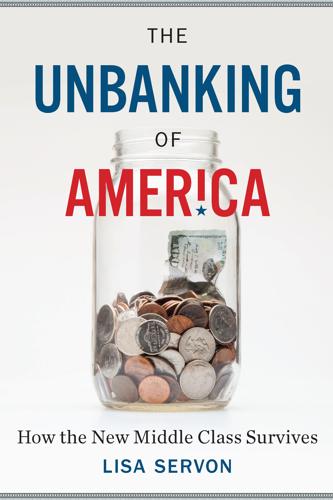
The Unbanking of America: How the New Middle Class Survives
by
Lisa Servon
Published 10 Jan 2017
Akerlof and Robert Shiller, Phishing for Phools: The Economics of Manipulation and Deception (Princeton, NJ: Princeton University Press), p. xi. 36 made it a common catchphrase: Renee Haltom, “Failure of Continental Illinois,” Federal Reserve History, November 22, 2013. http://www.federalreservehistory.org/Events/DetailView/47 37 “other people’s money”: Other People’s Money is the title of Louis Brandeis’s 1914 treatise. “virtue-less cycle”: Edmund Conway, “Bank of England Says Financiers Are Fuelling an Economic Doom Loop,” The Telegraph, November 6, 2009. http://www.telegraph.co.uk/finance/financialcrisis/6516579/Bank-of-England-says-financiers-are-fuelling-an-economic-doom-loop.html the remaining 6,395 banks: Ryan Tracy, “Tally of US Banks Sinks to Record Low,” Wall Street Journal, December 3, 2013. http://online.wsj.com/articles/SB10001424052702304579404579232343313671258; Steve Schafer, “Five Biggest US Banks Control Nearly Half of Industry’s $15 Trillion in Assets,” Forbes.com blog, December 3, 2014. http://www.forbes.com/sites/steveschaefer/2014/12/03/five-biggest-banks-trillion-jpmorgan-citi-bankamerica/#1dfa5ee51d43 declined by 85 percent: Finkle, “Is Dodd-Frank Really Killing Small Banks?”
…
When Washington Mutual went under during the financial crisis in 2008, the bank was seven times larger than Continental Illinois had been. But because banks know they’re “too big to fail” and that the government will bail them out, they continue to engage in risky behavior with “other people’s money”—our money. The potential for high profits is incredibly seductive. Some call the relationship between banks and government a “doom loop,” a “virtue-less cycle in which banks take ever greater risks to boost returns . . . and governments are forced to break their promises ‘never again’ to bankroll losses.” Today, the four largest banks—Chase, Bank of America, Wells Fargo, and Citigroup—collectively hold about half of all US bank assets, a total of $6.8 trillion, while the remaining 6,395 banks share the other half.
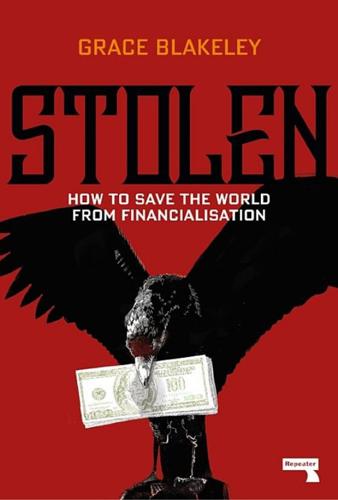
Stolen: How to Save the World From Financialisation
by
Grace Blakeley
Published 9 Sep 2019
As inequality rises, the demand deficit increases because those on lower incomes spend a higher proportion of their incomes on goods and services, whilst the wealthier tend to save more. Low demand is, in turn, likely to make businesses invest less, decreasing future profits, and therefore wages and employment. But instead of this low-investment, low-wage, low-demand doom-loop, we’ve seen corporate profits rising on average. What’s been going on? As Jack Welch has pointed out, shareholder value — as interpreted by the corporate raiders of the 1980s — really is the dumbest idea in the world. Many of those companies that cut investment, loaded up on debt, and dished out money to shareholders didn’t last very long.
…
The long and slow decline of the UK’s manufacturing sector, which invests more in fixed capital than the services sector, also contributed. Falling pay, rising inequality, and low investment threatened to recreate the conditions that preceded the Great Depression. Keynes and others argued that the best way to combat the low-wage, low-investment, low-demand doom-loop was for the government to intervene at strategic points to curb the twists and turns of the business cycle. They would signal their willingness to do this by committing to maintaining full employment, whatever the stage of the business cycle. If unemployment was rising, the state would step in to pick up the slack — either by directing increasing spending or cutting interest rates to boost investment in the private sector.
…
Almost as soon as the chimera of asset price inflation and the speculative profits of the finance sector evaporated, the Anglo-American experiment in finance-led growth ground to a halt. Austerity Economics Ordinarily, in such a context, one would expect the government to step in and pick up the slack. During times of insufficient demand, Keynes argued that states could mitigate the doom-loops of falling investment and consumption by lowering interest rates and boosting government spending. During the golden age of capitalism, this is exactly what social democratic states all around the world did. But today, they’ve chosen to implement austerity, which has made things even worse.31 The IMF — which famously imposed extremely harsh austerity programmes in the global South in the 1970s and 1980s — recently released a report concluding that “the benefits [of austerity]… are fairly difficult to establish”, but “the costs in terms of increased inequality are prominent”.32 Over the short term, the fund argues that shrinking the state by 1% of GDP increases the long-term unemployment rate by 0.6 percentage points.

MegaThreats: Ten Dangerous Trends That Imperil Our Future, and How to Survive Them
by
Nouriel Roubini
Published 17 Oct 2022
Creditors with less clout and longer-term claims are often forced to settle for a fraction of their claims, increasing their own exposure to insolvency. A doom loop ensues. Banks, corporations, and households bailed out by their governments only increase the size of public debt—putting the state at risk. Conversely, because banks, corporations, and households own the new public debt, a nation at risk of bankruptcy exposes the private sector to bankruptcy too. This doom loop animated the eurozone crisis between 2010 and 2015. And that was with far less public debt in the balance than now exists, after the COVID-19 crisis.
…
The public debt of the government is owned by households directly or indirectly—directly when savings are in government bonds; indirectly when savings are deposited in banks that buy government bonds. If banks go bust or if the government defaults, then how will banks pay depositors? This is the doom loop all over again. Defaults as a way of resolving debt problems are ugly business. They cause many complications. First you see a credit crunch. Then banks collapse. Credit dries up. Corporations go bust. People lose jobs. Households lose their incomes and homes. The stock market tanks. It’s not as if the Mother of All Defaults is a nice biblical moratorium where you erase all debt.

Why We Can't Afford the Rich
by
Andrew Sayer
Published 6 Nov 2014
If the financial sector were to pay for the damage it has done throughout the economy and put its house in order, we could say that the situation was merely one of malfunctioning and repair, but since the victims have had to bail out the perpetrators, who remain free to repeat the crime, it’s also a straightforward injustice. After all the puffed-up, self-congratulatory talk from the financial sector of expertise in ‘risk management’, it was ordinary people who had to pick up the tab. Doom loops The surge in government demand for credit to cover the direct costs of propping up the financial system and the indirect costs of growing unemployment, underemployment, and diminishing tax receipts has helped, with more than a little irony, to put highly lucrative new business the way of many of the financial institutions that had to be rescued by the state in the first place.137 When banks know they are too big to fail and that governments will always bail them out, they are likely to take bigger risks threatening bigger crises, which will need even bigger bailouts, which makes them take bigger risks still … The extraordinary cost of bailing out banks weakens government finances, and so when they need to borrow from banks, the banks insist on higher interest rates to protect themselves against the risk of governments defaulting, though this of course weakens state finances still further; and if that threatens banks lending to them, they will need bailing out … So when governments rescued the banks from going under, the rescued threatened to drown the rescuers; who then needed rescuing by the rescued, who then … As Benjamin Kunkel comments: A far simpler and more effective monetary policy would have been for the government to print a new batch of money, distribute an equal amount to everyone, then sit back and watch as stagnant economies were stirred to life by the spending and debts were paid down and eroded by temporarily higher inflation.
…
He also included in his recommendation ‘the euthanasia of the cumulative oppressive power of the capitalist to exploit the scarcity value of capital’. 95 Keynes, J.M. (1933) ‘National self-sufficiency’, The Yale Review, 22(4), pp 755–69. 96 Henwood, D. (1997) Wall Street, London: Verso, p 5. 97 Tawney, R.H. (2004) [1920] The acquisitive society, Mineola, NY: Harcourt Brace and Howe. 98 Adam Smith thought it was justifiable only in special cases. 99 Andrew Haldane at the Bank of England argues that in view of this, banks inevitably increased risks to maximise shareholder value: ‘For shareholders, the sky is the limit but the floor is always just beneath their feet. To maximise shareholder value, therefore, banks need simply to seek bigger and riskier bets.’ Haldane, A. (2012) ‘The doom loop’, London Review of Books, 34(4), 23 February, pp 21–2. 100 On this see Randy Martin’s excellent (2007) The financialisation of everyday life, Houndmills, Baskingstoke: Palgrave. 101 Personal share ownership in the UK has fallen proportionately in the last 50 years, from 54% of shares on the London Stock Exchange in 1963 to 10% in 2010 (BBC News, 27 January 2010, http://news.bbc.co.uk/1/hi/business/8482601.stm). 102 Department for Work and Pensions, Family Resources Survey, 2009–10, Table 6.7; and Froud, J., Johal, S., Haslam, C. and Williams, K. (2001) ‘Accumulation under conditions of inequality’, Review of International Political Economy, 8(1), pp 66–95. 103 Langley, P. (2007) ‘The uncertain subjects of Anglo-American financialization’, Cultural Critique 65, pp 66–91. 104 Engelen, E., Ertürk, I., Froud, J., Johal, S., Leaver, A., Moran, M., Nilsson, A. and Williams, K. (2011) After the great complacence: Financial crisis and the politics of reform, Oxford: Oxford University Press. 105 Froud et al (2001).
…
Apart from income from salary or investments, the remainder of incomes for all groups comes from self-employment and from pensions and other benefits. 124 de Goede, M. (2005) Virtue, fortune and faith: A genealogy of finance, Minneapolis: University of Minnesota Press. 125 For an example of this kind of bogus claim, see Vincent Amanor-Boadu (2008) ‘In defense of speculation’, http://www.agmanager.info/marketing/publications/marketing/InDefenceofSpeculation.pdf. 126 Tabb (2012), p 53; MacKenzie, D. (2011) ‘How to make money in microseconds’, London Review of Books, 33(10), pp 16–18; Lanchester, J. (2014) ‘Scalpers Inc. review of Flash Boys: Cracking the money code’, London Review of Books, 36(11), pp 7–9. 127 Norfield, T. (2012) ‘Derivatives and capitalist markets: the speculative heart of capital’, Historical Materialism, 20(1), pp 103–32. 128 Niederhoffer, V. (1989) ‘The speculator as hero’, Wall Street Journal, 2 October, http://www.dailyspeculations.com/vic/spec_as_hero.html. 129 Cooper (2008). See also Henwood, D. (1998) Wall Street, London: Verso. 130 Haldane, A. (2012) ‘The doom loop’, London Review of Books, 34(4), February. 131 Blackburn, R. (2008) ‘The subprime crisis’, New Left Review, 50, pp 63–106. 132 Shaxson, N. (2012) Treasure islands, London: Vintage, p 69. 133 Cited in Ingham, G. (2012) Capitalism, 2nd edn, Cambridge: Polity, p 154. 134 The Economist, 29 April 2006, p 78, cited in Ingham (2012), p 157 135 Engelen, E., Ertürk, I., Froud, J., Johal, S., Leaver, A., Moran, M., Nilsson, A. and Williams, K. (2011) After the great complacence: Financial crisis and the politics of reform, Oxford: Oxford University Press, ch 3. 136 ‘America’s billion-dollar-a-year men’, Too Much, 4 April 2011, http://toomuchonline.org/weeklies2011/apr042011.html. 137 Engelen et al (2011), ch 3. 138 Inman, P. (2012) ‘Black Wednesday 20 years on: how the day unfolded’, Guardian, 13 September, http://www.theguardian.com/business/2012/sep/13/black-wednesday-20-years-pound-erm. 139 Hutton, W. (2008) ‘As we suffer, City speculators are moving in for the kill’, Observer, 29 June, http://www.theguardian.com/commentisfree/2008/jun/29/investmentfunds.creditcrunch. 140 On this see Randy Martin’s (2007) The financialisation of everyday life, Houndmills, Basingstoke: Palgrave.

Stress Test: Reflections on Financial Crises
by
Timothy F. Geithner
Published 11 May 2014
A mere drop in housing prices could not have triggered mass mortgage defaults or depression-level losses in the banking system, but as unemployment increased and jobless homeowners missed payments, actual and expected mortgage losses increased as well, triggering margin calls and selloffs of mortgage-related assets, making the economy, unemployment, and the housing market worse. We weren’t prepared for that kind of doom loop. You could say our failures of foresight were primarily failures of imagination, like the failure to foresee terrorists flying planes into buildings before September 11. But severe financial crises had happened for centuries in multiple countries, in many shapes and forms, always with pretty bad outcomes.
…
“Perhaps too good.” In my usual stilted Fed-speak, I painted a dark picture of investors fleeing to safety, banks hoarding liquidity, and creditors mistrusting counterparties. “The danger this poses,” I said, “is the risk of an adverse, self-reinforcing dynamic”—in other words, a vicious cycle, a doom loop. Really, we had already fallen into that dynamic, and we hadn’t figured out a way to reverse it, or even to slow it down. BY CHRISTMAS, I felt bone tired and numb. My family and I used airline miles to visit Bali, but even Bali didn’t offer much of an escape. It was the rainy season. We all got sick.
…
We decided Treasury would inject $40 billion in new capital through TARP, while the Fed would restructure our $112.8 billion in earlier support to AIG by creating two complex new Maiden Lane vehicles, similar to the structure used for Bear. We then transferred the mortgage-related paper that was prompting the margin calls into those vehicles. The idea was to help AIG continue to meet its obligations, while roping off the distressed assets that had propelled the company into a doom loop. We hoped this would be a tourniquet to stop the bleeding, rather than another mere transfusion of cash that would need to be followed up by still more transfusions. The numbers were so large that we decided it was at least worth exploring whether AIG’s counterparties would accept voluntary haircuts on their claims.
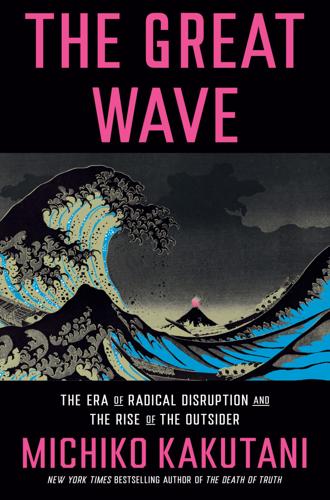
The Great Wave: The Era of Radical Disruption and the Rise of the Outsider
by
Michiko Kakutani
Published 20 Feb 2024
Trump and his allies actually wanted to amplify people’s mistrust in government or what they called the “deep state”: They wanted to conduct what Trump adviser Steve Bannon called the “deconstruction of the administrative state,” which translated into the mass jettisoning of regulations (including the rollback of more than a hundred environmental rules), and budget proposals that slashed social safety net programs like food stamps, Medicaid, and anti-poverty initiatives. Not only were government agencies undermined from within as experts were replaced by ideologues and cronies, but Trump’s own incompetence, corruption, and contempt for the Constitution created a doom loop that further subverted voters’ trust in government—a doom loop exacerbated by a dysfunctional Congress hobbled by toxic partisanship and archaic and easily abused procedural rules; and a Supreme Court increasingly oblivious to public opinion and long-standing precedent. The confluence of these two phenomena—growing public skepticism of institutions and technology that gave ordinary people a megaphone to make their ideas and opinions heard—forged the era of political instability and uncertainty we are living in today.

The Politics Industry: How Political Innovation Can Break Partisan Gridlock and Save Our Democracy
by
Katherine M. Gehl
and
Michael E. Porter
Published 14 Sep 2020
Cameron Easley, “America’s Most and Least Popular Governors: Q1 2018 Rankings,” Morning Consult, April 12, 2018, https://morningconsult.com/2018/04/12/americas-most-and-least-popular-governors/. 27. Greg Orman, A Declaration of Independents: How We Can Break the Two-Party Stranglehold and Restore the American Dream (Austin, TX: Greenleaf Group Book Press, 2016), 61. 28. Lee Drutman, Breaking the Two-Party Doom Loop: The Case for Multiparty Democracy in America (New York; Oxford: Oxford University Press, 2020), 31. 29. Russell Berman, “Cruz: Political ‘Tsunami’ Needed to Win Fight to Defund Obamacare,” The Hill, August 25, 2013, https://thehill.com/video/sunday-shows/318647-cruz-tsunami-needed-to-defund-obamacare. 30.
…
Sarah John and Andrew Douglas, “Candidate Civility and Voter Engagement in Seven Cities with Ranked Choice Voting,” National Civic Review 106, no. 1 (2017): 25–29. 9. Denise Munro Robb, “The Effects on Democracy of Instant Runoff Voting” (PhD diss., University of California Irvine, 2011). 10. Lee Drutman, Breaking the Two-Party Doom Loop: The Case for Multiparty Democracy in America (New York; Oxford: Oxford University Press, 2020). 11. Robert Pear, “If Only Laws Were Like Sausages,” New York Times, December 4, 2010, https://www.nytimes.com/2010/12/05/weekinreview/05pear.html. 12. Mike Gallagher, “How to Salvage Congress,” Atlantic, November 13, 2018, https://www.theatlantic.com/ideas/archive/2018/11/gallagher-congress/575689/. 13.

The Great Demographic Reversal: Ageing Societies, Waning Inequality, and an Inflation Revival
by
Charles Goodhart
and
Manoj Pradhan
Published 8 Aug 2020
But the history, for example of sovereign default, implies that memories are relatively short, so that a prospective recovery of the defaulting debtor need not prevent a return to financial markets for very long. Nevertheless, in such circumstances, where there is a clear-cut default, the creditor involved has to take an offsetting immediate hit to their own balance sheet. Thus, default can have far greater systemic effects than renegotiation; the problems of the ‘doom loop’ between banks and sovereigns are a case in point. So, both because of the costly implications of default for borrowers, and the widening systemic effect of such default on creditors, default by borrowers is an extreme, and unhappy, response to excessive debt burdens, perhaps more so than either renegotiation or a slightly higher rate of inflation.
…
Destination-Based Cash Flow Taxes (DBCFT) Destination-based element Devereux, M. Diabetes Digital services Direct medical costs Direct social sector costs Disinflation Disinflation in US, partly caused by age-structure Disinflation, owing to demography Dividends, payment discretionary Division Chief Doha Domesday Book ‘Doom loop’, between sovereigns and banks Drugs Drugs, cancer-related Duffy, R. Durable manufactured goods, falling price of Durant, W. Duration, significant reduction in Dwyer, J. Dynamism E Early cycle, of population growth ‘Ease of Doing Business’ East Asia Eastern Europe Eberly, J.
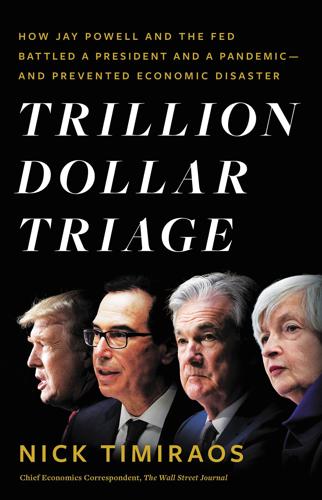
Trillion Dollar Triage: How Jay Powell and the Fed Battled a President and a Pandemic---And Prevented Economic Disaster
by
Nick Timiraos
Published 1 Mar 2022
“The American people are looking for answers and hope, and you’re doing sensationalism,” said Trump.1 The president was right: The American people were looking for answers and hope—as were the battered markets—but they wouldn’t get it from hydroxychloroquine. They needed it in part from a major relief package that Congress had put together with lightning speed over the past seventy-two hours. Trump, however, continued to be mostly a spectator during the most consequential legislation of his presidency. “The Doom Loop” Normally in a crisis, the senior brass from Treasury and the White House might solicit ideas from Congress. The ideas that emerge aren’t always that good. After listening thoughtfully, administration officials might say, “Those ideas are OK, but here’s what we’re actually going to do.” Then they bring the plan.
…
Hubbard turned his attention to a pair of Republican senators, Marco Rubio and Susan Collins, whom Mitch McConnell had tasked with developing a small-business relief program. Some Republicans were choking on the spending estimates that Hubbard and others were throwing around. To Hubbard, aggressive fiscal action now was by far the cheaper option to break what he called “the doom loop”—his worry that a massive supply shock would turn into a demand shock. If trade disruptions or health precautions forced businesses to idle their factories or close stores, more workers would go without paychecks, further sapping demand and forcing businesses to make more drastic layoffs. Missed rent or a wave of bankruptcies would put pressure on landlords—and, in turn, on the banking system.

The Lords of Easy Money: How the Federal Reserve Broke the American Economy
by
Christopher Leonard
Published 11 Jan 2022
European banks and governments owed their debt in dollars, so the European Central Bank couldn’t just create more dollars to bail them out as the Fed had done in the United States. The Fed had been working hard to stop the bleeding, extending the “swap lines” that flooded Europe with dollars. But there was only so much the swap lines could do. By 2012, Europe was at risk of entering a “doom loop,” whereby failed government loans would damage the banks, which in turn would suffer huge losses and drag down growth, making it even harder for the governments to pay off further debt. As always, this threatened the United States because a massive European downturn would hurt demand for U.S. goods.
…
W., 126, 156, 161, 162, 229 Bush, George W., 93 business development corporations (BDCs), 181 Cantor Fitzgerald, 115 Capitol siege, 299–300 CARES Act, 283–87, 299, 304 Carlucci, Frank, 162 Carlyle Group, 126, 161–63, 174, 178–80, 182 Powell at, 126, 161–63, 165–69, 185, 186, 229, 290 Rexnord and, 163, 165–69, 185, 186 Carpenter, Seth, 137–39, 147 Carrier, 197, 198 Carter, Jimmy, 161 Catholic University, 225–26 CDO (collateralized debt obligation), 149, 174, 345 defined, 343 Centers for Disease Control and Prevention, U.S., 262 Cheesecake Factory, 284 Chicago, Federal Reserve Bank of, 65–66 China, 111, 235, 237, 238 coronavirus in, 261, 262 Trump and, 235 Citadel Securities, 289–90 Citigroup, 115, 271 Clarida, Richard, 247, 250, 280n Clinton, Hillary, 197, 228 CLO (collateralized loan obligation), 149, 170, 173–78, 180, 182, 212, 271, 279, 281, 282, 286, 298, 305 defined, 343–44 CMBSs (commercial mortgage-backed securities), 214–16, 247, 254, 266, 268, 304 CNBC, 144 CNN, 109 collateralized debt obligation (CDO), 149, 174, 345 defined, 343 collateralized loan obligation, see CLO commercial mortgage-backed securities (CMBSs), 214–16, 247, 254, 266, 268, 304 Committee for a Responsible Federal Budget, 284 Congress, 13–15, 79, 80, 100, 101, 103, 104, 134–36, 140, 204, 207, 290, 304 Bernanke’s testimony before, 99, 109 coronavirus relief and, 276–77, 283–85, 299, 304 Fed and, 47, 48, 58, 75–78 Fed’s emergency powers limited by, 277 Greenspan’s hearings with, 75–78, 83, 86 interstate banking laws loosened by, 96–97 Salomon Brothers and, 160 conservatives, 16, 80, 108–12, 225, 257, 286, 346 see also Republican Party Constitution, U.S., 44 consumer debt, 296 Consumer Financial Protection Bureau, 204 Conti-Brown, Peter, 132 Continental Illinois National Bank and Trust Co., 65–66, 68–69, 97, 98, 100 Corker, Bob, 203–4, 206 coronavirus, 54, 259, 261–73, 276, 281–83, 293–95, 301, 304, 305 essential workers and, 294 GameStop and, 300 inflation and, 297 coronavirus relief and bailout programs, 276–92, 295, 297, 304, 343 CARES Act, 283–87, 299, 304 long-term effects of, 301 Main Street Lending Program, 279, 286–87, 297 Mnuchin and, 273, 276–77, 283, 285–86, 299 Paycheck Protection Program, 284, 285 Powell and, 265, 267, 268, 272–73, 277–78, 280, 280n, 283, 290, 291, 296–97 quantitative easing and, 267, 279–80, 297 special-purpose vehicles (SPVs), 278–83, 299, 350 stock market and, 287–90, 297–98 Trump and, 276, 283–85 unequal distribution of aid from, 284–85, 287, 292, 295 corporate debt, 73, 145, 149, 153–56, 163, 175, 181–82, 266, 270, 304 change in market for, 177–78 CLOs and, 170, 173–78, 180, 182 coronavirus relief and, 287, 299 Fed’s purchase of, 279 fracking and, 213–14, 216 high levels of, 262 increase in, 181, 199–200 interest rates on, 279 leveraged loans, see leveraged loans market for, 298 rolling of, 155, 298 and search for yield, 212–13 spreads on, 269 see also bonds cost of living, 50 cost push, 61, 344, 345 Courage to Act, The (Bernanke), 22, 34 COVID-19, see coronavirus Cov-lite loans, 179–81 Credit Suisse, 115, 170, 171–80, 183, 191–92 currencies, 45, 112, 217, 225, 350 Currency Wars (Rickards), 111 deflation, 96n, 223–24, 237 deleveraging events, 247 Dell, Michael, 276 Delta Airlines, 298 demand pull, 61–62, 344–45 democratic institutions, 103–4, 231–32, 305 media and, 108 Democratic Party, 13, 21, 79, 100, 135, 203, 206, 233, 276 see also liberals Denmark, 218 depressions, 96n Great Depression, 17–18, 23, 49, 58, 64, 79, 89, 100, 202, 204, 228, 283, 286, 345, 348 derivatives, 42, 157, 160, 174, 204, 207, 219 defined, 345 developing nations, 216–17 Dillon, Read & Co., 153–56, 161, 270 discount window, 46, 58, 64, 269 defined, 345 Discourse, 301 Dodd-Frank Act, 203, 204, 207, 209, 229, 252, 277, 350 dollar creation of, 4, 6 Fed’s effort to devalue, 111 global market for, 242 use of word, 4 see also money doom loop, 135 DoorDash, 297 Doral Country Club, 166 dot-com bubble, 20, 54, 232, 298 doves, 16–19, 152 defined, 346 Dow Jones Industrial Average, 24, 85, 146, 212, 231, 233, 236, 257, 259, 263, 265, 268, 300 coronavirus relief and, 287 Drudge Report, 110 Dudley, William, 34, 222, 248–49 Duke, Elizabeth “Betsy,” 34, 125, 127–30, 132, 141–44, 147, 148 Dune Capital, 276 Eccles Building, 21–22, 31, 56, 69, 71, 125, 241, 265–66 economics, 42 Hoenig’s study of and views on, 5, 36–37, 41–42, 302 Keynesian, 81, 100–101, 347 economists, 131–33, 136, 223 economy, global, see global economy economy, U.S., 8, 24, 27–28, 50, 88, 133, 170, 238, 259, 304 cycles and patterns in, 72–74, 95, 238 depressions in, see depressions debt overhang and, 73–75, 102, 126 Fed as central driver of policy making for, 15, 75, 114–16, 120–21 GDP in, 302 Greenspan’s perceived role in, 76–77, 87, 93 growth of, 72–74, 76, 78, 86, 99, 105, 121, 126, 136, 140, 212, 221, 225, 233, 238, 246, 295, 302 interest rates and, 7 New Deal and, 79 recessions in, 8, 22, 24, 50, 56, 60, 72, 73, 75, 80, 81, 136, 186, 225, 236, 302, 347 ZIRP and, 121 elections, 14, 228, 230, 298–99 El-Erian, Mohamed A., 231–32 English, Bill, 30 Erdogan, Recep Tayyip, 216–17 ESL Investments, 276 Europe, 24, 134–35, 210, 238 negative-interest-rate bonds in, 217–18 European Central Bank (ECB), 134–35, 218, 235, 237–38, 345 European Union, 237, 345 Evans, Charles, 12 everything bubble, 212 Exchequer Club, 205–6 ExxonMobil, 298 Ezer, Michelle, 137, 138 Falk Corporation, 168 farmland, 50–51, 55, 57, 92, 98 Farr, Michael, 152–53 Federal Communications Commission (FCC), 162 Federal Deposit Insurance Corporation (FDIC), 64, 207, 229, 252 bank failures and, 208–9 banks liquidated by, 64 banks’ living wills and, 208 consumer bank accounts protected by, 80, 202, 345 Continental Illinois and, 66 creation of, 64, 80, 202, 345, 348 defined, 345 Global Capital Index published by, 210 Hoenig at, 200, 201–11, 218–19, 230–31, 257 Penn Square and, 64, 65 Federal Open Market Committee (FOMC), 3–4, 7–13, 15, 20–21, 24–25, 50, 60, 68, 69, 72, 91–93, 95, 104, 221, 222, 241, 244, 246, 272, 297 consensus in, 12–13, 15, 29, 31, 104, 108 coronavirus and, 265–68, 278, 280 defined, 346 and devaluation of dollar, 111 economists in, 131–32 governors in, 48 Hoenig as sitting member of, 71–72, 81 Hoenig as voting member of, 22, 74, 75, 81, 87, 88, 92, 102, 104, 105 Hoenig’s dissenting votes in, 3–5, 8–13, 15, 18, 19, 24–25, 29, 32, 34, 75, 82, 84, 88, 104, 107–9, 112, 120, 301 Hoenig’s relationships in, 11–12, 15 media and, 108–9, 144 members of, 4, 9–12, 15, 31, 48, 60, 62, 120 open market operations and, 247–48 political disputes in, 81 quantitative easing debates at, 9, 10, 16, 27–34, 112, 121, 126–30, 132, 134, 137, 140, 142, 143 quantitative easing presentation at, 136–39 quantitative easing voting in, 3, 8–11, 18, 21, 29, 32–34, 105, 107–9, 112, 113, 134, 136–37, 141, 148 Volcker and, 67 voting and culture in, 82–83 Federal Reserve (U.S.

Shutdown: How COVID Shook the World's Economy
by
Adam Tooze
Published 15 Nov 2021
If the damage had been limited to Italy, that would have been bad enough. But France and Spain were hard hit too. Though they were not in Italy’s league of indebtedness, the coronavirus shock would push them above the 100 percent debt-to-GDP ratio that was a psychological threshold for the markets. Most worryingly, there were signs of a doom loop in which fears about sovereign debt became linked to worries about the financial stability of major banks. As the yields on Italian government bonds spiked, so too did the cost of insuring against default the debt of Italy’s two major banks—UniCredit and Intesa Sanpaolo.5 The level of the risk was still judged to be moderate, but the very fact of a linkage was concerning.6 If the aim was financial stability for Europe, it was no mystery what needed to be done.
…
Ashworth, “Italy’s Debt Is Less Terrifying Than It Looks,” Bloomberg, April 9, 2020. 3. A. Tooze, Crashed: How a Decade of Financial Crises Changed the World (Viking, 2018). 4. R. Olivares-Caminal, “The New EU Architecture to Avert a Sovereign Debt Crisis: EFSM, EFSF & ESM,” October 2011; www.oecd.org/daf/fin/48887542.pdf. 5. J. Detrixhe, “Europe’s ‘Doom Loop’ of Government Debt Is Alive and Well,” Quartz, May 13, 2020. 6. “Financial Stability Review,” European Central Bank, May 2020. 7. Eurostat, “First Quarter of 2020 Compared with Fourth Quarter of 2019,” ec.europa.eu/eurostat/documents/2995521/11129607/2-22072020-AP-EN.pdf/ab6cd4ff-ec57-d984-e85a-41a351df1ffd. 8.

Uncontrolled Spread: Why COVID-19 Crushed Us and How We Can Defeat the Next Pandemic
by
Scott Gottlieb
Published 20 Sep 2021
Matthew Pottinger and others had urged restricting travel from Europe much earlier than our March 11 ban that affected travelers from twenty-six European countries, but the proposal met resistance from Secretary of the Treasury Steven Mnuchin and others on the economic team, who worried about the financial impact of such a move.26 The economists had been worried that the virus, and our actions to stop its spread, could trigger a “doom loop” in their vernacular. This is a situation where a sharp and sudden drawdown in the supply of goods and services eventually leads to a corresponding decline in demand for these economic products, which further erodes their supply.27 In retrospect, we could never stop the virus at our borders. At best, we could have delayed its fuller entry.
…
Department of (DOD), 154, 156, 161, 285, 294, 345, 366 Defense Production Act (DPA) of 1950, 287 Dengue fever, 101, 102 Denmark, 214 Detroit, 208, 210 DeWine, Mike, 221–22 Dexamethasone, 288 Diabetes, 390–91 Diagnostic tests. See Testing Dialysis facilities, 300–301 Dick, Philip K., 248 Disease forecasting, 248–49 Disease surveillance. See Surveillance DNA amplification, 63, 152, 410n Domestic Policy Council (DPC), 14, 16, 17, 243–44, 266 “Doom loop,” 91 Drago, Al, 384–85 Drive-through testing sites, in South Korea, 259–60 Drug manufacturing, 161–63, 265–69, 313–19 Drug side effects, 235, 293–94, 330, 332–33 Ebola virus, 21, 57, 284, 309, 310, 348, 350, 352, 366, 372, 378 E. coli outbreak, 129–30 Eisenhower Executive Office Building, 59, 381 Eli Lilly, 308–9, 311–14, 388, 453n Ellison, Larry, 292–93 Elmhurst Hospital, 2 Embecovirus, 356 Emergency Use Authorization (EUA), 97–98, 103, 108–9, 118–19, 126, 258 hydroxychloroquine, 292–94 Pfizer vaccine, 336 Emergent BioSolutions, 316–17 Enterovirus (EV-D68), 16–17 Epidemic Intelligence Service (EIS), 345 Epitope, 456n Erasmus Medical Center, 364–65 Erbitux, 453–54n European Union (EU) and vaccines, 392 Expanded access, 305–6 Eylea, 453–54n Facebook, 129 Face masks.
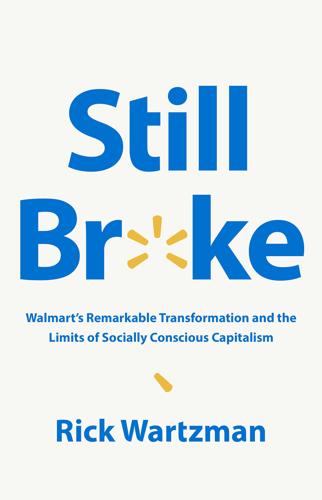
Still Broke: Walmart's Remarkable Transformation and the Limits of Socially Conscious Capitalism
by
Rick Wartzman
Published 15 Nov 2022
With stock literally lost inside the store, they began to manually bypass the normal ordering system for merchandise in the hope, McKenna said, that “I can get my hands on it because I’ll know where it is.” However, many of these items didn’t sell, either. They’d be returned to the back room, as well, adding to the mountain of clutter. “It created a doom loop,” Carithers said. As they made the rounds, Foran and McKenna also saw how much employees’ long-festering concerns about low pay and erratic hours were exacerbating Walmart’s troubles. Coupled with the stress brought on by the logjam of inventory, work for many had become insufferable. “I went into a store in North Carolina, and their turnover was 400 percent,” McKenna said.

Aftershocks: Pandemic Politics and the End of the Old International Order
by
Colin Kahl
and
Thomas Wright
Published 23 Aug 2021
Such a regime offers permanent protections to those with high incomes from financial assets; everyone else gets little more than temporary help in times of crisis.14 Financial Times columnist Edward Luce pointed out that the problem was that the United States was overly reliant on the Federal Reserve as a blunt instrument. This, he wrote, “tightens a doom loop in which the U.S. sovereign must eventually reckon with the ever-widening class of risk it is underwriting.”15 The wealthy asset-owning class and major companies thrive, while families and individuals who do not own stocks and bonds get left behind. “WE’RE NOT HERE TO COVER SPREADS” The European Central Bank had been slow to respond to the euro financial crisis, which began in 2009.
…
“Interview with Christine Lagarde, President of the ECB, Conducted by Matthieu Pelloli and Published on 9 April 2020,” European Central Bank, April 8, 2020, https://www.ecb.europa.eu/press/inter/date/2020/html/ecb.in200408~2e7bcefbe5.en.html. 22. Chris Giles, Robin Harding, Brendan Greeley, and Martin Arnold, “Calls for Policymakers to Act to Prevent Coronavirus ‘Doom Loop,’” Financial Times, March 1, 2020, https://www.ft.com/content/58410fea-5a30-11ea-a528-dd0f971febbc. 23. Jon Cunliffe, “The Impact of Leveraged Investors on Market Liquidity and Financial Stability,” Bank of England, November 12, 2020, https://www.bankofengland.co.uk/-/media/boe/files/speech/2020/the-impact-of-leveraged-investors-on-market-liquidity-and-financial-stability-speech-by-jon-cunliffe.pdf. 24.

Cloudmoney: Cash, Cards, Crypto, and the War for Our Wallets
by
Brett Scott
Published 4 Jul 2022
Rather, they collect data from millions of users and cross-reference it to create statistical clusters of songs and people that tend to overlap. In the realm of music suggestion that may produce some beautiful synergies (or maybe get you trapped in a bubble), but in the realm of finance it may really matter if you find yourself in a Kafkaesque doom-loop of mis-categorisation. And there are countless possible mis-categorisations. To use a light-hearted example, I discovered that Twitter’s Robo-Sherlocks have me categorised – among other things – as a possible ‘working-class mom’. In Twitter’s case this may mean I’m shown adverts for cut-price family holidays, but in the case of a bank it could mean getting blacklisted from credit, or even its opposite – getting enticed into over-indebtedness.
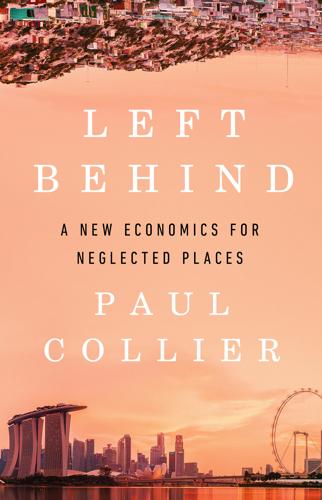
Left Behind
by
Paul Collier
Published 6 Aug 2024
They are predominantly found within commuting distance of London, with its concentration of high-paying jobs in finance, law and government.10 They could not have gained those jobs without their university degree, which leads us back to the biases in education policy. The overall message of Left Behind is joyful: communities long left behind can catch up. But the tone of this chapter has been far from joyful: its account of Britain’s doom-loop of education and privilege has been angry – I think justifiably so. From the next chapter, good news abounds, but first there is one final unhappy fact to be revealed. Over the past four decades, as each of Britain’s age cohorts arrives on the jobs market, these anxious jobseekers have faced deteriorating opportunities.
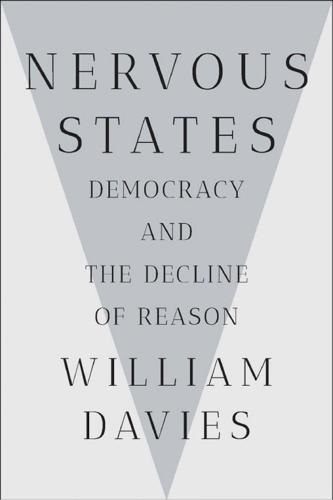
Nervous States: Democracy and the Decline of Reason
by
William Davies
Published 26 Feb 2019
How can I know that what I see is actually real, and not simply an illusion as experienced in a dream? Given the way a stick appears to bend when it is placed in water, why should I trust the data that I receive via my eyes? In fact, how can I know that I even exist at all? Descartes’ famous escape from this doom-loop of doubt was to consider that the very fact of him having these doubts is enough to demonstrate that he existed, at least as a thinking being, if not as a bodily one: “I think therefore I am.” However, the realm of the thinking, metaphysical mind (of which I can be certain) and that of the feeling, physical body (of which I am uncertain) would become split into parallel spheres of reality.

13 Bankers: The Wall Street Takeover and the Next Financial Meltdown
by
Simon Johnson
and
James Kwak
Published 29 Mar 2010
But as Piergiorgio Alessandri and Andrew Haldane of the Bank of England argue, this stance becomes less and less credible: “The ex-post costs of crisis mean such a statement lacks credibility. Knowing this, the rational response by market participants is to double their bets. This adds to the cost of future crises. And the larger these costs, the lower the credibility of ‘never again’ announcements. This is a doom loop.”42 The third problem is that TBTF banks are bad for competition and therefore bad for the economy. Bond investors realize that megabanks have an implicit government guarantee, and therefore they are willing to lend them money at lower interest rates than their smaller competitors. This is why large banks could pay 0.78 percentage points less for money than small banks in the wake of the financial crisis, giving them a huge competitive advantage.
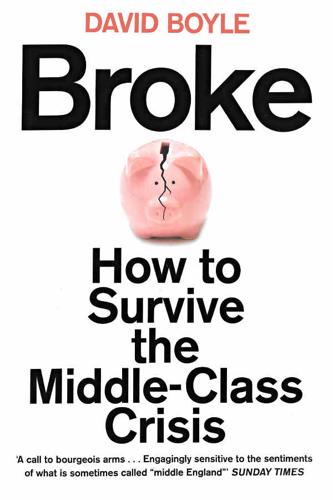
Broke: How to Survive the Middle Class Crisis
by
David Boyle
Published 15 Jan 2014
[4] Hugo Young, One of Us: A Biography of Margaret Thatcher (London, Pan Books, 1989), 269. [5] Kynaston, 625. [6] Kynaston, 625. [7] Kynaston, 629. [8] Bernard Attard, ‘The Stock Exchange: An oral history’, interview with David Hopkinson, 26 Jun. 1990. [9] BBC 2, The Secret History of Our Streets, ‘Portland Road’, 27 Jun. 2012. [10] Andrew Haldane, ‘The doom loop’, London Review of Books, 23 Feb. 2012. [11] http://epicureandealmaker.blogspot.com [12] Quoted in John Cassidy, ‘What good is Wall Street?’, New Yorker, 29 Nov. 2010. [13] Kynaston, 631. [14] Kynaston, 643. [15] Kynaston, 652. [16] Kynaston, 692. [17] The Times, 19 May 1984. [18] Sunday Times, 1 Aug. 1986

Boom: Bubbles and the End of Stagnation
by
Byrne Hobart
and
Tobias Huber
Published 29 Oct 2024
They offer a domain where the Stalins, the Cesare Borgias, and other ruthless types can satisfy their ambition by participating in positive-sum games. Indeed, there is a strong, empirically documented relationship between a zero-sum mindset and the economic environment: The more adverse the economic environment, the less positive-sum the thinking becomes. 151 Scarcity thinking kicks off a self-reinforcing doom loop, which results in more scarcity. Bubbles represent an escape in another sense. An economy that’s growing output without technological progress is not truly static but in decline. Some economic inputs are effectively infinite, like creativity, or renewable, like crops. But many inputs deplete over time.

The Measure of Progress: Counting What Really Matters
by
Diane Coyle
Published 15 Apr 2025
This “time tax” is one of the new costs of doing business as a h uman being in t oday’s advanced economies, to the extent that, in August 2024, the Biden Administration launched a “Time Is Money” regulatory crackdown on corporations involving measures such as making it easier for people to cancel subscriptions or get automatic refunds, instead of getting caught in customer s ervice “doom loops.” Corporations seem to have forgotten that their purpose is to serve customers rather than raise their share prices (Mayer 2023), so that pharmaceutical companies profit from illness, financial services companies profit when customers lose out, insurance companies only want the customers unlikely to need to claim, and food companies make more when they sell people the most processed and unhealthy products.
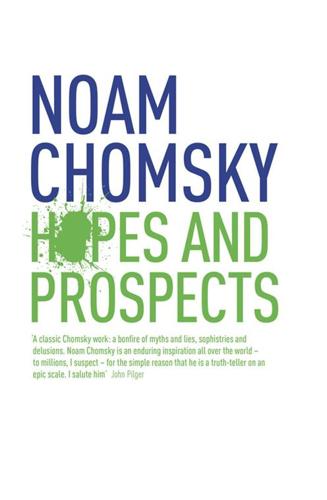
Hopes and Prospects
by
Noam Chomsky
Published 1 Jan 2009
Whenever it fails, we rely on lax money and fiscal policies to bail it out. This response teaches the financial sector: take large gambles to get paid handsomely, and don’t worry about the costs—they will be paid by taxpayers” through bailouts and lost jobs, and the financial system “is thus resurrected to gamble again—and to fail again.” The system is a “doom loop,” in the words of the official of the Bank of England responsible for financial stability.5 One might say “better late than never,” except that the chances of any meaningful financial regulation appear to be dim, given the grip of the financial industry on the government, matters to which we return.

The Great Experiment: Why Diverse Democracies Fall Apart and How They Can Endure
by
Yascha Mounk
Published 19 Apr 2022
GO TO NOTE REFERENCE IN TEXT Under the new electoral rules, those 24,700: “Top Court Confirms Prodi’s Win in Italian Election,” New York Times, April 19, 2006, https://www.nytimes.com/2006/04/19/world/europe/top-court-confirms-prodis-win-in-italian-election.html. GO TO NOTE REFERENCE IN TEXT Some believe that popular anger: Lee Drutman, Breaking the Two-Party Doom Loop: The Case for Multiparty Democracy in America (New York: Oxford University Press, 2020). For a legislative proposal, see “The Fair Representation Act,” Fair Vote, accessed September 26, 2021, https://www.fairvote.org/fair_rep_in_congress#why_rcv_for_congress. GO TO NOTE REFERENCE IN TEXT Others argue that Democrats would finally: See, for example, Quinta Jurecic and Susan Hennessey, “The Reckless Race to Confirm Amy Coney Barrett Justifies Court Packing,” Atlantic, October 4, 2020, https://www.theatlantic.com/ideas/archive/2020/10/skeptic-case-court-packing/616607, and Adam Serwer, “The Supreme Court Is Helping Republicans Rig Elections,” Atlantic, October 22, 2020, https://www.theatlantic.com/ideas/archive/2020/10/dont-let-supreme-court-choose-its-own-electorate/616808.

How the Other Half Banks: Exclusion, Exploitation, and the Threat to Democracy
by
Mehrsa Baradaran
Published 5 Oct 2015
And they frankly own the place.”121 Senator Elizabeth Warren has also repeatedly voiced outrage at the coziness between Washington and Wall Street, repeating the phrase, “The game is rigged.”122 Demands are rising across the political spectrum, including from Joseph Stiglitz, Simon Johnson, Paul Krugman, Richard Fisher, and even the king of deregulation, Alan Greenspan, for breaking up the banks.123 We cannot have a banking system that is so large and powerful that it relies on government bailouts. Their size leads to bailouts, and the promise of bailouts in turn leads to more risk-taking, a cycle some have called a “doom loop.”124 If the deep-seated fears of concentrated bank power had not been pacified over the last several decades, they would surely have intensified during the recent government bailout of the banking industry. As it turned out, the banks and bankers had become so powerful that many efforts to regulate the industry after the bailouts were thwarted.
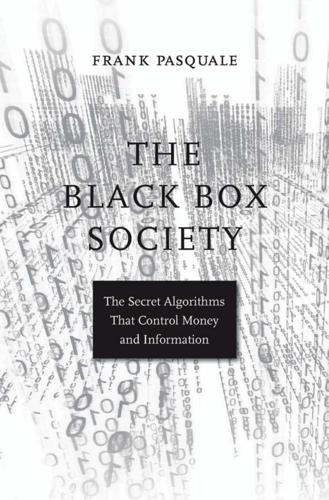
The Black Box Society: The Secret Algorithms That Control Money and Information
by
Frank Pasquale
Published 17 Nov 2014
Like the alliances of business and law enforcement in fusion centers, the cooperation of big bank and big government leaders is supposed to reassure us. Experts at the commanding heights of business and government are in harmony, sharing a common vision. But, as Peter Boone and Simon Johnson have shown, the interconnections between the two can also erode confidence. Boone and Johnson foresee a “doom loop”: as financial institutions are increasingly treated as too big to fail, they are empowered to take greater and greater risks, which will inevitably lead to greater stresses on the governments that effectively sponsor them.146 These obligations foment worries about governments’ ability to support both too-big-to-fail banks and the tens of millions who depend on health and welfare benefits.
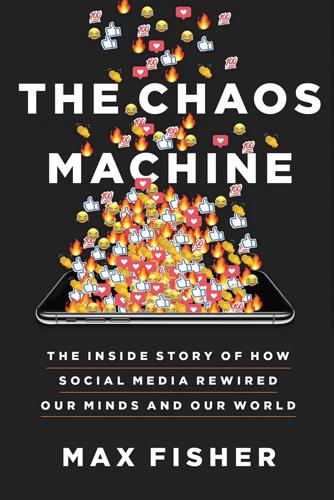
The Chaos Machine: The Inside Story of How Social Media Rewired Our Minds and Our World
by
Max Fisher
Published 5 Sep 2022
But by the mid-2010s social networks had become the vector through which much of the world’s news was consumed and interpreted. This created a world, Tosi and Warmke warned in a follow-up study with the psychologist Joshua Grubbs, defined by “homogeneity, ingroup/outgroup biases, and a culture that encourages outrage.” The result was a doom-loop of polarization and misinformation. When Congress passed a stimulus package in 2020, for example, the most-shared posts on Twitter reported that the bill siphoned $500 million meant for low-income Americans to Israel’s government and another $154 million for the National Art Gallery, that it funded a clandestine $33 million operation to overthrow Venezuela’s president, that it slashed unemployment benefits, and that $600 Covid-relief checks were really just loans that the IRS would take back on the following year’s taxes.
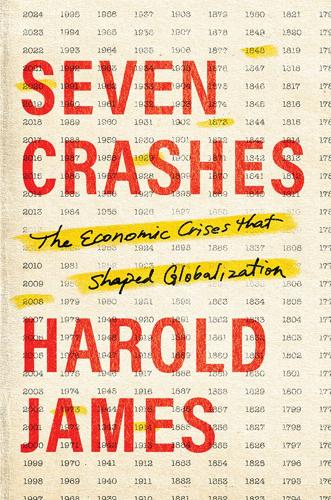
Seven Crashes: The Economic Crises That Shaped Globalization
by
Harold James
Published 15 Jan 2023
George Osborne’s theory rested on the belief that eliminating the structural deficit within four years would provide room for maneuver, and for spending on long-term investment rather than on social transfers. A key part of the bad dynamic in Greece—but also elsewhere in the Eurozone and in the UK—was the doom loop which linked banks and governments in multiple ways. The simplest linkage was through the cost of bailouts of bad banks: that involved a fiscal expense, so the creditworthiness of the government sank and the yields on bonds rose, with the result that their prices fell. But the government debt appeared as an asset on bank balance sheets, whose capital was thus further eroded.
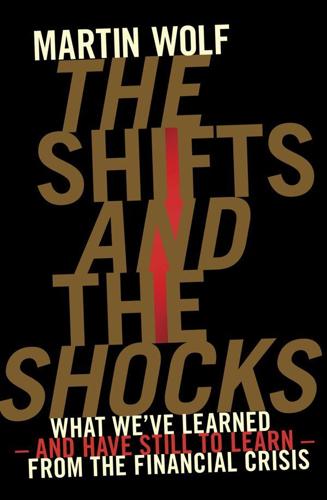
The Shifts and the Shocks: What We've Learned--And Have Still to Learn--From the Financial Crisis
by
Martin Wolf
Published 24 Nov 2015
Such a banking union will require strong central regulation and supervision and, in particular, strong macroprudential regulation, at least to try to prevent the sort of runaway credit booms that led to such disasters. The Eurozone has gone quite a long way to meeting these conditions in its agreement on banking union of March 2014.17 Yet if a banking union is to work, there must exist an adequate supply of unimpeachably safe assets, thereby breaking the doom loop between the sovereigns and their banks. Relying on the debt of just a few countries, principally Germany, is inadequate, particularly since Germany wishes to lower its public debt relative to the economy. For this reason, there has to be an adequate supply of eurobonds – bonds for which the Eurozone states are jointly and severally liable.

Them And Us: Politics, Greed And Inequality - Why We Need A Fair Society
by
Will Hutton
Published 30 Sep 2010
If they are allowed to do so, by the time of the next crisis the banking system will be even larger, so the next credit crunch – which is highly likely without reform, according to internal Bank of England working papers – will be even more devastating. Slump or inflation would be almost unavoidable in what Andrew Haldane, executive director of the Bank of England, calls a doom loop.5 Meanwhile, the rest of the economy has been reeling from the consequences, experiencing the biggest recession since the 1930s. The evidence is daunting. No country has recovered quickly from such an economic calamity. It is not just the crisis in the provision of credit that constrains economic growth.
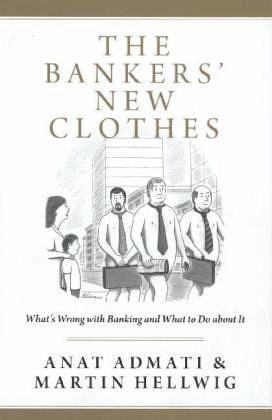
The Bankers' New Clothes: What's Wrong With Banking and What to Do About It
by
Anat Admati
and
Martin Hellwig
Published 15 Feb 2013
Speech delivered at the American Economic Association, Denver, January 9. ———. 2011b. “Control Rights (and Wrongs).” Wincott Annual Memorial Lecture, West-minster, London, October 24. ———. 2011c. “Accounting for Banks’ Uncertainty.” Speech delivered at the Institute of Chartered Accountants in England and Wales, London, December 19. ———. 2012a. “The Doom Loop.” London Review of Books 34 (4): 21–22. ———. 2012b. “Creating a Socially Useful Financial System.” Speech delivered at the Institute of New Economic Thinking’s “Paradigm Lost” conference in Berlin. ———. 2012c. “The Dog and the Frisbee.” Speech delivered at the Federal Reserve Bank of Kansas City’s 366th economic policy symposium, Jackson Hole, Wyoming, August 31.

The Price of Time: The Real Story of Interest
by
Edward Chancellor
Published 15 Aug 2022
These complex investment strategies had much in common with portfolio insurance, whose programmed sales triggered the October 1987 stock market crash.48 On 5 February 2018, a slight pick-up in the VIX index forced volatility sellers to cover their positions. A scramble to buy volatility protection drove the VIX higher, creating a doom loop of losses and liquidations. Over the course of the day, the VIX doubled, its largest increase on record. Credit Suisse’s exchange-traded note lost 97 per cent of its value, triggering a ‘liquidation event’. Investors lost every cent of their too-good-to-be-true profits. US stocks experienced their sharpest decline in years, shaving around a trillion dollars off the market’s capitalization and yet … nothing whatsoever had happened on Main Street where ordinary people earned their living.

On the Edge: The Art of Risking Everything
by
Nate Silver
Published 12 Aug 2024
“You need your full attention on where you are and what you can do to help it to ensure it’s going right…and adapt and adjust if it starts to not go right,” she said. Again, it’s natural to feel physical anxiety in high-stakes situations, which produce profound physiological changes to your body. It’s mistaking these sensations for being out of control that can produce a self-fulfilling doom loop. If you don’t want that to happen in a poker tournament, then you definitely don’t want it to happen when you’re flying two hundred miles above the Earth’s surface. Granted, this is easier said than done—it’s why Sullivan was chosen to be an astronaut when ten thousand of her competitors were not.